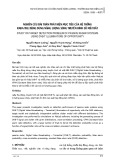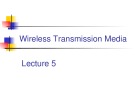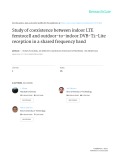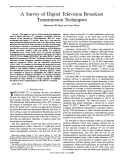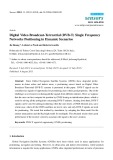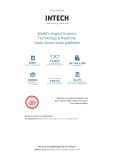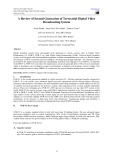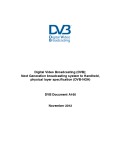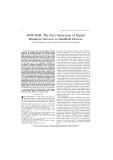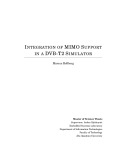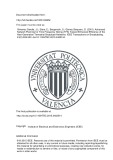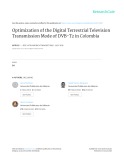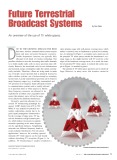
Terrestrial broadcasting
-
Bài viết này trình bày các kết quả nghiên cứu khảo sát các chỉ tiêu chất lượng phát hiện của hệ thống rađa thụ động dùng năng lượng sóng truyền hình số mặt đất DVB-T (Digital Video Broadcasting – Terrestrial) với mô hình mục tiêu Swerling 5 đứng yên và mô hình nhiễu cộng tính, độc lập thống kê theo các phân bố khác nhau. Mời các bạn cùng tham khảo!
 9p
9p  octoberer
octoberer
 25-06-2021
25-06-2021
 37
37
 2
2
 Download
Download
-
Lecture Wireless and mobile computing – Chapter 5: Wireless transmission media. The following will be discussed in this chapter: Wireless transmission, wireless transmission examples, terrestrial microwave, satellite microwave, broadcast radio, infrared, wireless transmission systems comparison, wireless propagation modes.
 41p
41p  nanhankhuoctai8
nanhankhuoctai8
 23-06-2020
23-06-2020
 13
13
 1
1
 Download
Download
-
This paper introduces the concept of a nonuniform constellation (NUC) in contrast to conventional uniform quadrature-amplitude modulation (QAM) constellations. Such constellations provide additional shaping gain, which allows reception at lower signal-to-noise ratios. ATSC3.0 will be the first major broadcasting standard, which completely uses NUCs due to their outstanding properties.
 7p
7p  son248
son248
 23-04-2020
23-04-2020
 64
64
 0
0
 Download
Download
-
Nowadays, the demand for high-quality multimedia services (video, audio, image, and data) is rapidly increasing. The Digital Video Broadcasting - terrestrial (DVB-T) standard, its second-generation version (DVB-T2), and the Long-Term Evolution (LTE) standard are the most promising systems to fulfill the demand for advanced multimedia services (e.g., high-definition image and video quality), especially in Europe. However, LTE mobile services can operate in a part of the UHF band allocated to DVB-T/T2 TV services previously.
 15p
15p  son248
son248
 24-03-2020
24-03-2020
 27
27
 2
2
 Download
Download
-
This paper is a survey of the transmission techniques used in digital television (TV) standards worldwide. With the increase in the demand for High-Definition (HD) TV, videoon-demand and mobile TV services, there was a real need for more bandwidth-efficient, flawless and crisp video quality, which motivated the migration from analogue to digital broadcasting. In this paper we present a brief history of the development of TV and then we survey the transmission technology used in different digital terrestrial, satellite, cable and mobile TV standards in different parts of the world.
 26p
26p  son248
son248
 24-03-2020
24-03-2020
 25
25
 1
1
 Download
Download
-
Since Global Navigation Satellite Systems (GNSS) show degraded performance in dense urban and indoor areas, a positioning sensor based on Digital Video Broadcast-Terrestrial (DVB-T) systems is presented in this paper. DVB-T signals can be considered as signals-of-opportunity for positioning, due to their good properties. One of the challenges to overcome is to distinguish the signals from different emitters. Here, we suppose that the user can first compute his position by GNSS during an initialization phase, which is used for solving all the ambiguities concerning DVB-T emitters.
 28p
28p  son248
son248
 24-03-2020
24-03-2020
 25
25
 1
1
 Download
Download
-
Digital Video Broadcasting-Terrestrial (DVB-T) is the most widely deployed digital terrestrial television system worldwide with services on air in over thirty countries. In order to increase its spectral efficiency and to enable new services the DVB consortium has developed a new standard named DVB-T2. A nearly definitive specification has already been published as a BlueBook as well as an implementation guideline, where the structure and main technical novelties of the standard have been defined.
 24p
24p  son248
son248
 24-03-2020
24-03-2020
 21
21
 1
1
 Download
Download
-
Digital broadcast systems have increasingly been deployed for various services such as Digital Video Broadcasting (i.e. DVB-S, DVB-T, etc.) and Digital Audio Broadcasting (DAB). Classical digital broadcast systems were designed with fixed modulation guarantee reliable communication even with very hostile channel environment. DVB-T2 terrestrial television standard is becoming increasingly important. The emergence of it is motivated by the higher spectral efficiency and adopting transition from analogue TV to DVB-T2, or transition from DVB-T to DVB-T2.
 7p
7p  son248
son248
 24-03-2020
24-03-2020
 27
27
 1
1
 Download
Download
-
DVB-T2 (Digital Video Broadcasting – Second Generation Terrestrial) is the extension of the television standard DVB-T. This system transmits compressed digital audio, video, and other data in PLPs (physical layer pipes), using OFDM modulation with channel coding and interleaving. This paper provides the performance evaluation of DVB-T2 for outdoor reception by the received signal measurement.
 6p
6p  son248
son248
 24-03-2020
24-03-2020
 21
21
 1
1
 Download
Download
-
The performance of propagation analysis of DVB-T2 (Digital Video Broadcasting – Second Generation Terrestrial) is very significant for digital television broadcasting. That will analyze the effectiveness of the setting parameters that use for suitable of broadcasting. This paper provides the performance evaluation of DVB-T2 for fixed reception by the received signal measurement. The field measurements were taken in Bangkok of Thailand, along 20 locations.
 6p
6p  son248
son248
 24-03-2020
24-03-2020
 20
20
 1
1
 Download
Download
-
In this paper we propose a MIMO channelprecoder that utilizes channel statistical structure and is suitable for terrestrial broadcasting systems, while being potentially transparent to the receivers. The performance of the channel-precoder is evaluated in a wide set of channel scenarios and mismatched channel conditions, a typical situation in the broadcast setup.
 14p
14p  son248
son248
 24-03-2020
24-03-2020
 18
18
 1
1
 Download
Download
-
Recently terrestrial digital broadcasting systems have experienced a growth with the demand of high-data rate. In order to meet such demand, the multiple-input multiple-output (MIMO) technology has received wide attention. This paper proposes a pre-coding method, which provides high-space channel correlation for the improved performance over terrestrial broadcasting channels when the MIMO spatial multiplexing (SM) is adopted for digital video broadcasting-next generation handheld systems.
 5p
5p  son248
son248
 24-03-2020
24-03-2020
 22
22
 2
2
 Download
Download
-
The standard consists of four parts each covering a different structure of the transmitter network: covers sheer terrestrial transmission with single and multi-aerial structures that require only a single aerial and tuner on the receiver side; covers sheer terrestrial transmission with multi-aerial structures on both ends. Terminals suitable for this profile need to employ two tuners as well...
 295p
295p  son248
son248
 24-03-2020
24-03-2020
 19
19
 1
1
 Download
Download
-
This paper reviews the main technical solutions adopted by the next-generation mobile broadcasting standard DVB-NGH, the handheld evolution of the second-generation digital terrestrial TV standard DVB-T2.
 12p
12p  son248
son248
 24-03-2020
24-03-2020
 20
20
 1
1
 Download
Download
-
This thesis examines the benefits of using multi-antenna transmission in terrestrial digital video broadcasting, especially in the DVB-T2 and DVBNGH standards. The thesis extends an existing DVB-T2 simulator with a platform for running MIMO simulations. The platform is constructed in a manner that will allow it to be easily adapted to future needs.
 92p
92p  son248
son248
 24-03-2020
24-03-2020
 17
17
 1
1
 Download
Download
-
The allocation of frequencies traditionally used by terrestrial broadcasting (digital dividend) to International Mobile Telecommunication (IMT) is limiting the evolution of the Digital Terrestrial Television (DTT) networks for enhanced service offering. Next-generation DTT standards are called to provide increased capacity within the reduced spectrum. Time Frequency Slicing (TFS) has been proposed as one of the key technologies for the future DTT networks.
 15p
15p  son248
son248
 24-03-2020
24-03-2020
 23
23
 1
1
 Download
Download
-
This article presents the research and development activities on digital video broadcasting carried by the Mobile Communications Group of the iTEAM research institute of the Universidad Politécnica de Valencia. iTEAM is a full member of the DVB standardization forum, and is actively participating in the standardization process of the next generation mobile TV standard DVB-NGH. iTEAM’s DVB facilities include a complete end-toend DVB-T/H/SH/T2 lab, and a DVB-T/H pilot at the main campus of the Universidad Politécnica de Valencia.
 5p
5p  son248
son248
 24-03-2020
24-03-2020
 15
15
 1
1
 Download
Download
-
This paper analyzes potential DVB-T2 transmission modes to optimize existing DTT network designs of Colombia, originally made for DVB-T, analyzing the trade-offs between capacity, coverage level and Single Frequency Network (SFN) size. Network planning results has been performed with a professional DTT network planning tool based on the three first deployment phases of the DTT network of the public national TV broadcaster RTVC. Results obtained fully justify the decision of adopting DVB-T2. Compared with the initial DVB-T design, DVB-T2 can increase the national covered population up to 7.
 8p
8p  son248
son248
 24-03-2020
24-03-2020
 17
17
 1
1
 Download
Download
-
This article provides a general overview of broadcasting and TV white spaces. However, some of the information is specific to the European market and, therefore, may not apply to other regions such as the United States.
 8p
8p  son248
son248
 24-03-2020
24-03-2020
 18
18
 0
0
 Download
Download
-
Utilising spectrum on the digital terrestrial television (DTT) platform means that many localities across the UK will have a chance to receive local TV services. However, this will not be universal given inherent constraints with spectrum and the DTT platform. Instead, localities not reached by local DTT broadcasts will in the future be able to receive local TV through internet protocol television (IPTV) which most set-top boxes and television sets have or will eventually have the capability of receiving.
 35p
35p  dambaotaikhoan
dambaotaikhoan
 06-05-2013
06-05-2013
 136
136
 4
4
 Download
Download








